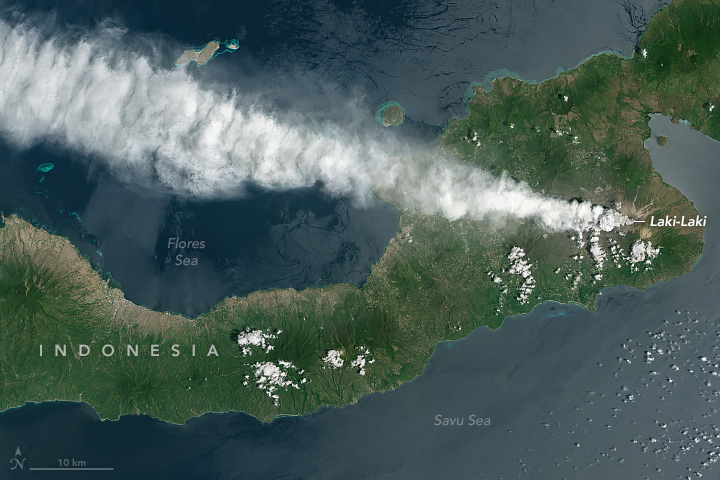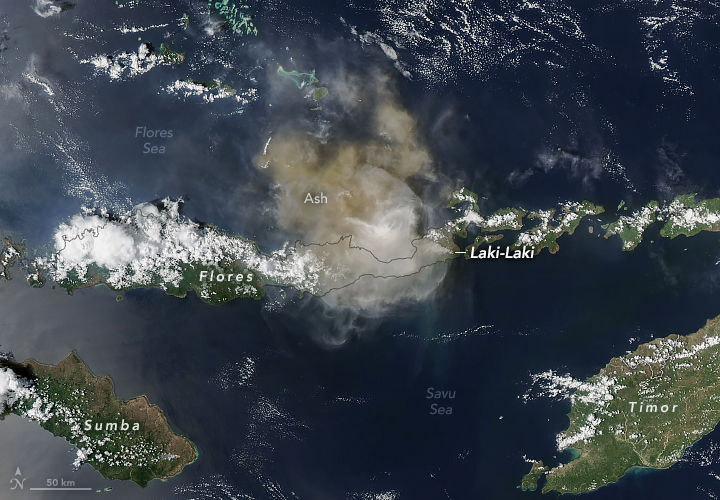
Indonesia Continues to Erupt
Downloads
- lewotobi_oli2_20241113_lrg.jpg (1343x896, JPEG)
- indonesiaeruption_amo_20241109_lrg.jpg (4133x3543, JPEG)
Metadata
- Sensor(s):
- Landsat 9 - OLI-2
- Aqua - MODIS
- Data Date: November 13, 2024
- Visualization Date: November 14, 2024
Following nearly two decades of quiet, Mount Lewotobi Laki-Laki—a volcano on the Indonesian island of Flores—began erupting again in December 2023. An especially intense period of activity in November 2024 included several explosive eruptions that generated deadly pyroclastic flows, darkened the landscape with ashfall, and lofted soaring ash plumes that disrupted air travel.
The OLI-2 (Operational Land Imager-2) on Landsat 9 captured this image of a volcanic plume streaming west from Laki-Laki on November 13, 2024. Indonesia’s Volcanology and Geological Hazard Mitigation Center (PVMBG) reported plume heights of 1,200 meters (3,900 feet) on November 13. This followed more-explosive eruptions the previous week, including one on November 7 that lofted ash as high as 17,000 meters (56,000 feet) and another on November 9 that reached 15,000 meters (49,000 feet), according to the Darwin Volcanic Ash Advisory Center (VAAC).
The MODIS (Moderate Resolution Imaging Spectroradiometer) on NASA’s Aqua satellite sensor captured an image (below) of the remnants of one of these high-flying, widely dispersed ash plumes over Flores on November 9. The aviation community tracks the movement of volcanic ash closely because it can cause damage to airplane windshields, airframes, wings, and engine components. At times, ash has caused engine failure. Jets generally cruise at heights above 10,000 meters, so ash plumes above this altitude pose a particular threat.
After the eruption on November 4, authorities elevated the aviation color code from orange to red, the highest on the scale. Airlines canceled more than 90 flights on November 13 alone and dozens of other flights on prior days due to ash, according to local news reports. Cancellations have affected both domestic and international flights, including flights into and out of Bali, an island popular among international travelers. Several airports temporarily closed after the November 4 eruption, though some had partially reopened by November 14, according to the Jakarta Globe.
Past research into aviation and volcanic hazards ranks Indonesia’s airports as the world’s third most vulnerable to volcanic activity. This was based on the number of active volcanoes that have caused problems in the past, the number of airports affected, and the total number of ash-related impacts. Other countries with high risk include the United States, Ecuador, Papua New Guinea, Italy, New Zealand, the Philippines, Mexico, Japan, and the United Kingdom.
An ongoing collaboration between the NASA Disasters program and several volcanic ash advisory centers, which includes a series of workshops, aims to develop safer and more efficient flight redirects around volcanic plumes using information collected by NASA satellites.
References
- Aydar, E. et al. (2024) Volcanic jets to commercial jets: synopsis and diagnosis. Bulletin of Volcanology, 86(71).
- BBC (2024, November 13) Bali flights cancelled due to dangerous volcanic ash. Accessed November 14, 2024.
- Bureau of Meteorology Darwin Volcanic Ash Advisory Centre. Accessed November 14, 2024.
- Global Volcanism Program (2024) Lewotobi: Most Recent Weekly Report (6 November-12 November). Accessed November 14, 2024.
- Guffanti, M., et al. (2009) Volcanic hazards to airports. Natural Hazards, 51, 287-302.
- NASA (2023) The NASA-VAAC initiative. Accessed November 14, 2024.
- NASA (2023, September 27) When Volcanoes Speak: Ash Advisory Centers Tap NASA Science for Safer Skies. Accessed November 14, 2024.
- NASA Earth Observatory (2024, November 7) Mount Lewotobi Laki-Laki Spews Ash. Accessed November 14, 2024.
- U.S. Geological Survey (2015) Aviation. Accessed November 14, 2024.
- U.S. Geological Survey (2015) Volcanic Ash. Accessed November 14, 2024.
- Volcanology and Geological Hazard Mitigation Center, via X (2024) See November Updates. Accessed November 14, 2024.
NASA Earth Observatory images by Michala Garrison, using Landsat data from the U.S. Geological Survey and MODIS data from NASA EOSDIS LANCE and GIBS/Worldview. Story by Adam Voiland.
This image record originally appeared on the Earth Observatory. Click here to view the full, original record.
